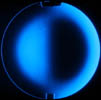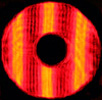November 14,
2010: Refiguring
a 14"
A 14" mirror came in for refiguring recently.
I'm
trying to show some examples of what I typically see, and this mirror,
though not the greatest, was fairly straightforward to fix.
Yet
another undercorrected mirror, the method to fix it is simple - add
correction.
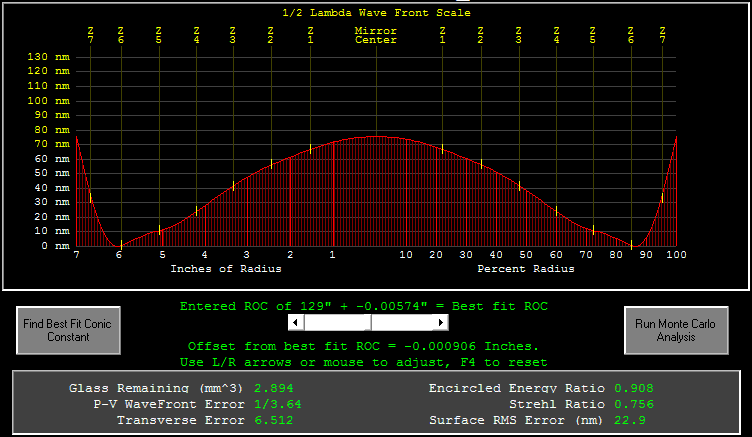
However,
that view is somewhat optimistic - it minimizes the peak-to-valley
error, but in general it is difficult to remove the "high" area near
the edge of the mirror. To try to do so could turn the edge,
roll
the outer zone, or both. So, we can adjust the radius of
curvature. This changes the parabola that we are trying to
match,
and this causes the center of the mirror to rise, while the outer zones
flatten out.
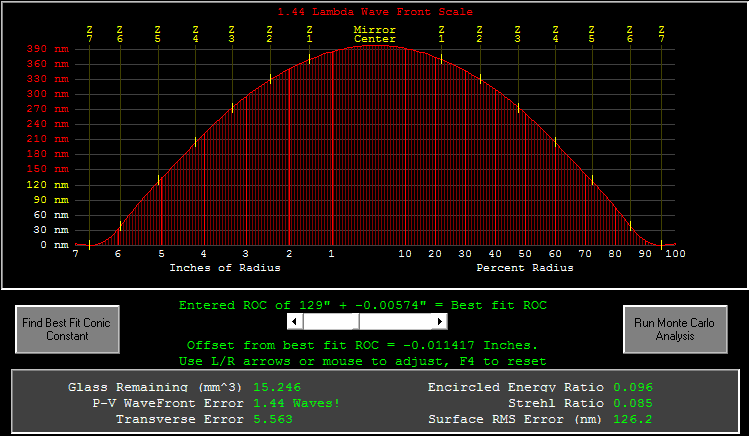
Thus,
there is more polishing to do, but the result will be a better mirror.
From this point, I can carefully polish away the glass inside
the
edge of the mirror to produce a superb figure that is good to the edge.
I
also tested the secondary, and found an approximately 1/4-wave rolloff
on one end (photo below, left) and some convexity. After
refiguring, much of the slope error was eliminated (photo below, right).
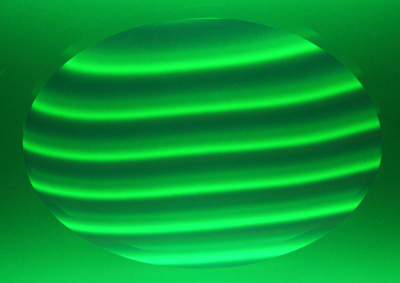
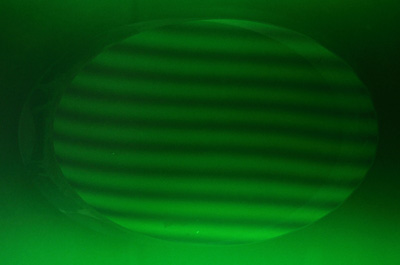
So
how did the primary turn out? Let's just say the remaining
error
on the primary was difficult to measure - I measured better than a
1/20th wave wavefront error, a transverse error of less than one, and a
Strehl of 0.99. Figure of revolution testing showed a very
good
figure of revolution. While measurements are not perfect,
together these all indicate a VERY good mirror.
These numbers are based on an actual set of measurements, so they are
not perfect, but they are also not up for debate.
Not convinced by my testing? Here's what the owner said about
the mirror after refiguring:
"OK,
it was two below zero and I got the scope out. The results
confirm my belief that no one should observe at temperatures below 20F
:). My hands got really frost bitten, I cursed metal and its
low
temperature properties, but in the end, the mirrors look pretty darn
good. Star images are definitely tighter than they were
before
refiguring but the real test came from the brilliant moon."
"Mike,
I have seen some darn good views in the past of the moon in scopes as
large as 30 inches, but what I saw tonight was totally unbelievable!"
"When the seeing finally settled and the mirrors cooled down enough to
use, the scope handled
from 527x to **836x** on the moon (*59.7x per inch* of aperture) which
is as high as I can go!!!"
"I was seeing things I
have *never* seen on the moon.
Hadley Rille's area showed incredible detail (the 2 km wide shallow
craterlet St. George was visible at the turn of the rille at the base
of the Hadley Delta mountain). There were a huge number of
tiny
secondary impact craters from Thebit to its west on the nearby maria
that I have never noted in images, let alone seen visually...."
"....I
won't be getting the scope back out until things warm up a lot (and
much of our snow melts), but for now, I am pretty darn satisfied as to
what kind of optics I have. Thanks again for picking up (the
other company's) fumble and running it back for a touchdown."
I think that says more than any number or set of numbers possibly could.
Please check back for future installements of "In
the Shop".
Mike
Lockwood
Lockwood Custom Optics
